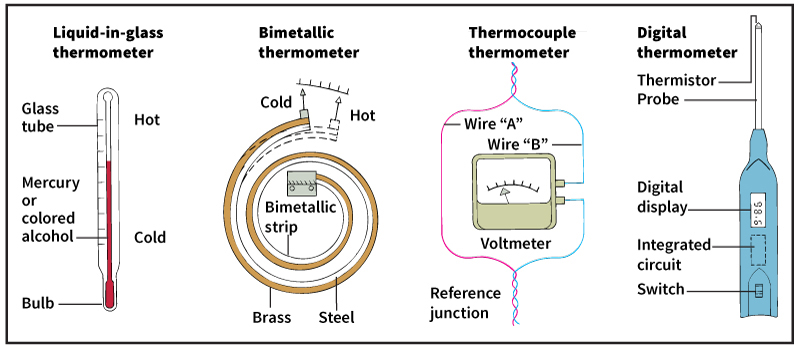Thermometer is an instrument that measures the temperature of gases, liquids, and solids. As the temperature of a substance changes, some of its chemical and physical properties also change. For example, substances may change in color, shape, or volume. A thermometer measures one of these changes and usually displays the size of the change as a number. This number can be converted to a temperature value by using a suitable temperature scale. Such scales include the Fahrenheit, Celsius, and Kelvin scales.
This article divides thermometers into five principal types. These types are (1) thermal expansion thermometers, (2) thermocouple thermometers, (3) resistance thermometers, (4) radiation thermometers, and (5) liquid crystal thermometers.

Thermal expansion thermometers
are the simplest and best-known thermometers. They measure changes in the volume of a substance as its temperature changes. The air thermometer was the oldest such thermometer. It was first used by European scientists in the 1500’s and early 1600’s. Air thermometers worked by measuring the length of a column of air in a glass tube open at one end. The open end of the tube was placed in a dish filled with water. As the temperature changed, air in the tube would expand or contract and move the water up or down the tube. A person could then estimate a temperature value based on the length of the air column.
By the mid-1600’s, air thermometers were replaced by more accurate instruments called liquid-in-glass thermometers. These instruments are still widely used for cooking, taking body temperature, and many other functions. They contain a very thin, sealed glass tube partially filled with liquid. When the temperature of the liquid increases, it expands and rises up the narrow tube. A scale attached to the tube expresses the height of the liquid column as a temperature value. Mercury has been the most frequently used liquid in these thermometers. Alcohol is also commonly used. Because mercury is poisonous, many people prefer mercury-free thermometers.
Two other thermal expansion thermometers are bimetallic thermometers and filled-system thermometers. Bimetallic thermometers consist of a band made from strips of two different metals. The metals are bonded together and coiled. As the temperature of the bimetallic band rises, each metal strip expands at a different rate. This alters the curve of the band. Filled-system thermometers contain a curved, flexible metal tube filled with gas or liquid. A rise in temperature makes the filling expand. The curve of the tube then changes to make room for the increased volume of gas or liquid. In both bimetallic and filled-system thermometers, the motion of one end of the instrument moves an indicating device along an attached scale to show the temperature. Manufacturing industries commonly use both thermometers.
Thermocouple thermometers
contain two wires of different metals. The wires are joined at both ends to form junctions, with one wire attached to an instrument called a voltmeter. When the two junctions are at different temperatures, a voltage develops between the two wires. The voltage increases as the temperature difference between the junctions grows. The voltmeter then measures and displays the voltage, which can be converted to a temperature reading. Many industries use thermocouple thermometers. These instruments can measure a much greater range of temperatures than other thermometers can.
Resistance thermometers
indicate temperature by measuring a material’s electrical resistance—that is, its opposition to the flow of electric current. Temperature changes cause variations in the amount of a material’s resistance. Generally, the greater the temperature change, the greater the change in resistance. Resistance thermometers measure the resistance of conductors and semiconductors, substances through which electric currents flow easily. Examples of these materials include copper, platinum, silicon, and various metal compounds. The thermometers then convert the resistance measurement to a temperature value. Resistance thermometers are also used extensively in industry.
A common resistance thermometer is the thermistor, or thermally sensitive resistor. Thermistors often consist of a tiny beadlike semiconductor attached to wire connectors. Thermistors can be used in battery-powered digital thermometers, where they are attached to the end of a slender metal device called a probe. Digital thermometers electronically display temperature readings on a digital screen.
Radiation thermometers,
also known as pyrometers, indicate temperature by detecting electromagnetic radiation (electric and magnetic energy). Every substance emits radiation in relation to its temperature. Radiation thermometers measure the radiation and convert the measurement to a temperature value.
A wide range of radiation thermometers exists. One of the most popular varieties is the IR thermometer, or infrared radiation thermometer. IR thermometers use electronic sensors to detect radiation from infrared (heat) rays. The thermometer then converts the measurement to a temperature reading. People use one type to take body temperature. This instrument measures temperature by detecting infrared rays from the eardrum.
Liquid crystal thermometers
measure temperature by using liquid crystals, compounds that have properties of both liquids and solids. Some liquid crystals change color as the temperature changes. These color changes can be related to a temperature scale. Liquid crystal thermometers come in different forms. In many examples, the crystals are applied to strips of tape. Liquid crystal thermometers are often used in aquariums to check water temperature. Some people use them to measure body temperature.
